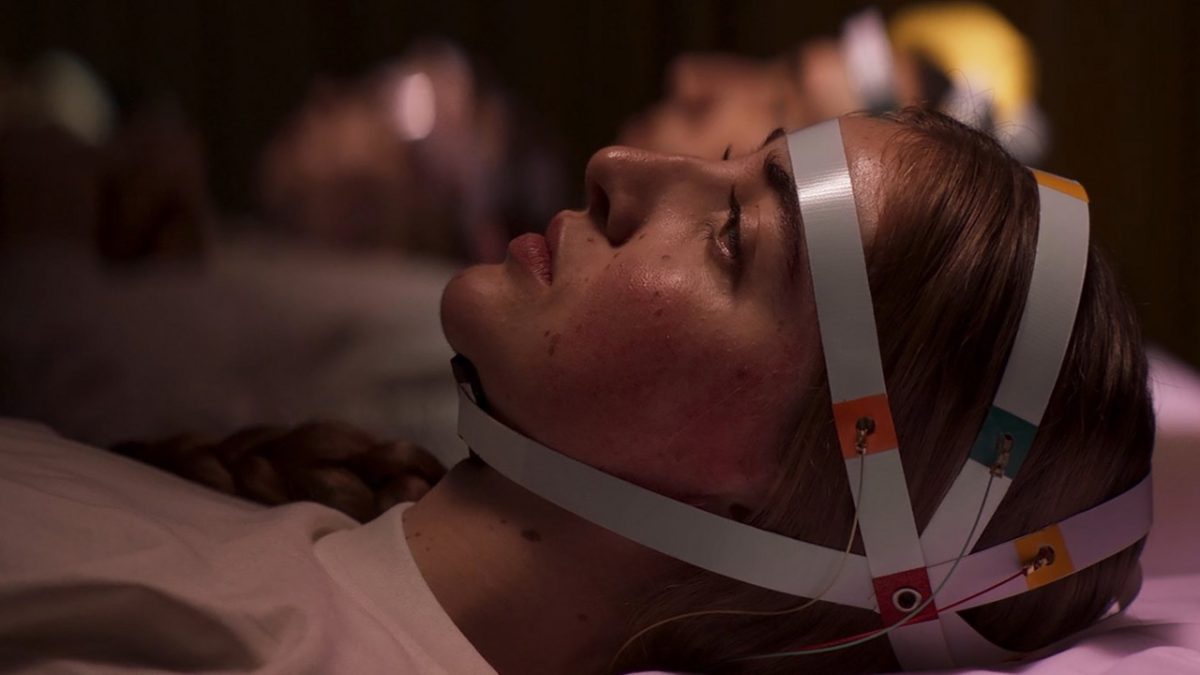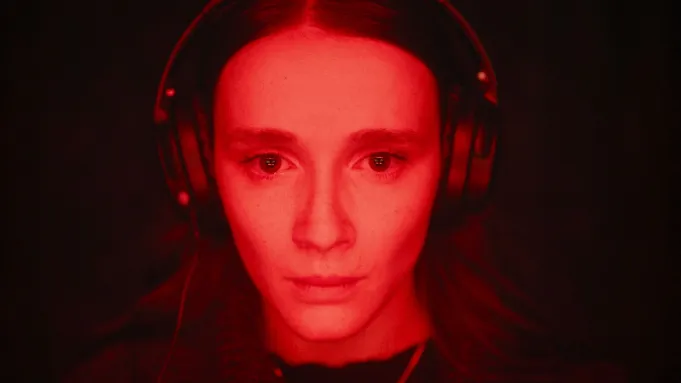Lucia Garibaldi’s “A Bright Future” (2025) takes place in a reality that does not feel too far off from where we are in the real world. It places its 18-year-old female protagonist, Elisa, in a world that rewards her subservience. It expects her to accept a fate chosen for her. No one cares about her choice or preference. She is almost reduced to being a commodity, valued solely for her beauty, intellect, or productivity. So, she rarely reflects on how their decisions affect her. She remains mainly passive, and her muted existence seems rooted in years of suppression.
Garibaldi’s film presents the dullness of Elisa’s everyday life with a dystopian world-building. The saturated hues of reds, yellows, and blues surround her no matter where she stands. However, it is farthest from Pedro Almodóvar’s surrealistic maximalism. Instead, it is heavily stripped down to the point it feels like a somber medical drama. Even the harshest reds feel closer to a clinical coldness that cuts out any sense of warmth or compassion in her environment. Her life is devoid of any shred of joyful optimism that may exist elsewhere. The film is steeped in this otherworldliness that appears thoroughly drab and dreary.
All these stylistic elements are in stark contrast to the film’s title for a reason. They allow the script to present this inherent irony by exploring how their world operates. It shows its characters living in a near-deserted town that offers happiness only through escape. The teenage protagonist, who should be enjoying the early years of her youth, does not find any space to express that youthful abandon, even if there is no dearth of space where she lives. Its vastness feels vapid and oppressive, where the only cause of celebration is a departure to a promised land, dubbed The North.
The only way Elisa can be happy is by leaving where she grew up. However, no one necessarily knows how the North looks or feels. They go by the word of those in charge of operations, who help bright minds like Elisa be prepared for that promised land. Elisa’s only connection to that other world is her sister, who moved there years ago. However, we never see her or hear her speak. It builds a mystery about the purpose and validity of this program that is supposed to offer a better future. Still, Elisa’s mother, Nelida, insists she must do everything it takes to be accepted by the North.

With all these details, Garibaldi’s film draws indisputable parallels to the real world that rewards conformity and obedience and considers even the slightest form of dissent offensive. They become even more prominent as Elisa evolves as an individual who forms her own opinions and learns to value them. She goes through an odd series of adventures that reveal a casual listlessness of her town more strikingly than before. Throughout her journey, she barely meets anyone her age beyond the confines of the adaptation program to prepare her for the North.
With this creative choice, Garibaldi offers a reason for Elisa’s ennui. She can’t envision a future when she cannot see anyone her age happy and filled with a lust for life. For the most part, she crosses paths with middle-aged people, who seem starved of their fundamental pleasures. They crave her youthful zeal while leaving her with any energy to begin with. She hardly smiles, and even when she does, it’s muted. So, her personality is nearly defined by her choice between conformity and resistance.
“A Better Future” captures Elisa’s emotional void through all its observational cues of her surroundings. However, it stays a little too invested in building this gloominess that it rarely lets any other emotion breathe. It conveys rigidity in Elisa’s life, stemming from the endless burden of discipline, but does not scrutinize the institutions that impose them. It focuses almost entirely on how the protagonist navigates her life and expects us to fill in the gaps about the things left unsaid. That elusiveness does not make up for a tedious drama that seems detached by its own intricacies.
What still grabs your attention in its familiar genre beats is a resonating quest for identity that fills their insipid lives with a semblance of life. It cleverly portrays the unjustified, often laughable roots of our hopes and fears. At its best, it is as melancholy as the Aki Kaurismäki films. However, it feels rather slight in its portrayal of a near-dystopian world.




![Enemies of the State [2020]: ‘TIFF’ Review – Bizarre hacktivist documentary unravels that everything is political](https://79468c92.delivery.rocketcdn.me/wp-content/uploads/2020/10/Enemies-of-the-State-768x384.jpg)


![Diorama [2022] Netflix Review: This Swedish Film Ruins a Relationship Drama with Unnecessary Tonal Shifts](https://79468c92.delivery.rocketcdn.me/wp-content/uploads/2022/09/Diorama-2022-Netflix-Review-768x576.webp)
![Against the Ice [2022] Netflix Review: A Flat Survivor Thriller that Never Quite Catches the Adventure Sprit](https://79468c92.delivery.rocketcdn.me/wp-content/uploads/2022/03/Against_the_Ice_20201024_Unit_02235_R-768x512.jpg)
